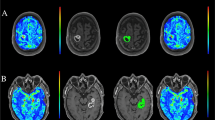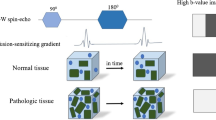Abstract
Although neuroimaging remains the foundation for the diagnosis of cerebrovascular disease, ongoing technologic advances have now opened up new frontiers for stroke evaluation and treatment. Neuroimaging studies can provide crucial information regarding tissue injury (size, location, and degree of reversibility of ischemic injury as well as presence of hemorrhage), vessel status (site and severity of stenoses and occlusions), and cerebral perfusion (size, location, and severity of hypoperfusion). This information can be combined to identify patients with salvageable penumbral tissue who may benefit most from acute therapies. The multimodal combinations of advanced imaging techniques, particularly in the realm of CT and MRI, have emerged as the most promising noninvasive approaches to acute stroke evaluation.
Similar content being viewed by others
References and Recommended Reading
Kidwell CS, Chalela JA, Saver JL, et al.: Prospective comparison of CT vs. DWI for detection of acute cerebral ischemia: results of a multicenter study. Paper presented at International Stroke Conference, New Orleans, LA, 2005.
Moulin T, Cattin F, Crepin-Leblond T, et al.: Early CT signs in acute middle cerebral artery infarction: predictive value for subsequent infarct locations and outcome. Neurology 1996, 47:366–375.
von Kummer R, Nolte PN, Schnittger H, et al.: Detectability of cerebral hemisphere ischaemic infarcts by CT within 6 h of stroke. Neuroradiology 1996, 38:31–33.
Lev MH, Farkas J, Gemmete JJ, et al.: Acute stroke: improved nonenhanced CT detection--benefits of softcopy interpretation by using variable window width and center level settings. Radiology 1999, 213:150–155.
Barber PA, Demchuk AM, Zhang J, et al.: Validity and reliability of a quantitative computed tomography score in predicting outcome of hyperacute stroke before thrombolytic therapy. ASPECTS Study Group. Alberta Stroke Programme Early CT Score. Lancet 2000, 355:1670–1674.
Adams HP, Jr., Adams RJ, Brott T, et al.: Guidelines for the early management of patients with ischemic stroke: A scientific statement from the Stroke Council of the American Stroke Association. Stroke 2003, 34:1056–1083.
Kidwell CS, Chalela JA, Saver JL, et al.: Comparison of MRI and CT for detection of acute intracerebral hemorrhage. JAMA 2004, 292:1823–1830. This prospective study suggests that MRI is as accurate as CT in detecting hyperacute intraparenchymal hemorrhage, and in some circumstances is even more sensitive than CT. It also confirms the superiority of gradient echo MRI over CT for the detection of chronic hemorrhage.
Sanelli PC, Lev MH, Eastwood JD, et al.: The effect of varying user-selected input parameters on quantitative values in CT perfusion maps. Acad Radiol 2004, 11:1085–1092.
Kloska SP, Nabavi DG, Gaus C, et al.: Acute stroke assessment with CT: do we need multimodal evaluation? Radiology 2004, 233:79–86.
Wintermark M, Fischbein NJ, Smith WS, et al.: Accuracy of dynamic perfusion CT with deconvolution in detecting acute hemispheric stroke. AJNR Am J Neuroradiol 2005, 26:104–112.
Klotz E, Konig M: Perfusion measurements of the brain: using dynamic CT for the quantitative assessment of cerebral ischemia in acute stroke. Eur J Radiol 1999, 30:170–184.
Wintermark M, Reichhart M, Thiran JP, et al.: Prognostic accuracy of cerebral blood flow measurement by perfusion computed tomography, at the time of emergency room admission, in acute stroke patients. Ann Neurol 2002, 51:417–432. This report demonstrates that perfusion CT may identify regions of both infarct and penumbra.
Wintermark M, Reichhart M, Cuisenaire O, et al.: Comparison of admission perfusion computed tomography and qualitative diffusion- and perfusion-weighted magnetic resonance imaging in acute stroke patients. Stroke 2002, 33:2025–2031.
Esteban JM, Cervera V: Perfusion CT and angio CT in the assessment of acute stroke. Neuroradiology 2004, 46:705–715.
Wildermuth S, Knauth M, Brandt T, et al.: Role of CT angiography in patient selection for thrombolytic therapy in acute hemispheric stroke. Stroke 1998, 29:935–938.
Shrier DA, Tanaka H, Numaguchi Y, et al.: CT angiography in the evaluation of acute stroke. AJNR Am J Neuroradiol 1997, 18:1011–1020.
Verro P, Tanenbaum LN, Borden NM, et al.: CT angiography in acute ischemic stroke: preliminary results. Stroke 2002, 33:276–278.
Mohr JP, Biller J, Hilal SK, et al.: Magnetic resonance versus computed tomographic imaging in acute stroke. Stroke 1995, 26:807–812.
Baird AE, Warach S: Magnetic resonance imaging of acute stroke. J Cereb Blood Flow Metab 1998, 18:583–609.
Schlaug G, Siewert B, Benfield A, et al.: Time course of the apparent diffusion coefficient (ADC) abnormality in human stroke. Neurology 1997, 49:113–119.
Kidwell CS, Alger JR, Di Salle F, et al.: Diffusion MRI in patients with transient ischemic attacks. Stroke 1999, 30:1174–1180.
Ay H, Oliveira-Filho J, Buonanno FS, et al.: ‘Footprints’ of transient ischemic attacks: a diffusion-weighted MRI study. Cerebrovasc Dis 2002, 14:177–186.
Engelter ST, Provenzale JM, Petrella JR, et al.: Diffusion MR imaging and transient ischemic attacks [letter; comment]. Stroke 1999, 30:2762–2763.
Fiebach JB, Schellinger PD, Gass A, et al.: Stroke magnetic resonance imaging is accurate in hyperacute intracerebral hemorrhage: a multicenter study on the validity of stroke imaging. Stroke 2004, 35:502–506.
Kidwell CS, Saver JL, Villablanca JP, et al.: Magnetic resonance imaging detection of microbleeds before thrombolysis: an emerging application. Stroke 2002, 33:95–98.
Fazekas F, Kleinert R, Roob G, et al.: Histopathologic analysis of foci of signal loss on gradient-echo T2*-weighted MR images in patients with spontaneous intracerebral hemorrhage: evidence of microangiopathy-related microbleeds. AJNR Am J Neuroradiol 1999, 20:637–642.
Tong DC, Yenari MA, Albers GW, et al.: Correlation of perfusion- and diffusion-weighted MRI with NIHSS score in acute (<6.5 hour) ischemic stroke. Neurology 1998, 50:864–870.
Butcher K, Parsons M, Baird T, et al.: Perfusion Thresholds in Acute Stroke Thrombolysis. Stroke 2003, 34:2159–2164.
Qureshi AI, Isa A, Cinnamon J, et al.: Magnetic resonance angiography in patients with brain infarction. J Neuroimag 1998, 8:65–70.
Scarabino T, Carriero A, Giannatempo GM, et al.: Contrastenhanced MR angiography (CE MRA) in the study of the carotid stenosis: comparison with digital subtraction angiography (DSA). J Neuroradiol 1999, 26:87–91.
Rasanen HT, Manninen HI, Vanninen RL, et al.: Mild carotid artery atherosclerosis: assessment by 3-dimensional time-of-flight magnetic resonance angiography, with reference to intravascular ultrasound imaging and contrast angiography. Stroke 1999, 30:827–833.
Jackson MR, Chang AS, Robles HA, et al.: Determination of 60% or greater carotid stenosis: a prospective comparison of magnetic resonance angiography and duplex ultrasound with conventional angiography. Vasc Surg 1998, 12:236–243.
Nederkoorn PJ, van der Graaf Y, Hunink MG: Duplex ultrasound and magnetic resonance angiography compared with digital subtraction angiography in carotid artery stenosis: a systematic review. Stroke 2003, 34:1324–1332.
Kidwell CS, Saver JL, Mattiello J, et al.: Thrombolytic reversal of acute human cerebral ischemic injury shown by diffusion/perfusion magnetic resonance imaging. Ann Neurol 2000, 47:462–469.
Kidwell CS, Alger JR, Saver JL: Beyond mismatch: evolving paradigms in imaging the ischemic penumbra with multimodal magnetic resonance imaging. Stroke 2003, 34:2729–2735.
Hacke W, Albers G, Al-Rawi Y, et al.: The Desmoteplase in Acute Ischemic Stroke Trial (DIAS): a phase II MRI-based 9-hour window acute stroke thrombolysis trial with intravenous desmoteplase. Stroke 2005, 36:66–73. This is the first prospective, randomized controlled thrombolytic stroke trial to use MRI both for determining patient eligibility and as a primary efficacy endpoint.
Barber PA, Parsons MW, Desmond PM, et al.: The use of PWI and DWI measures in the design of "proof-of-concept" stroke trials. J Neuroimaging 2004, 14:123–132.
Author information
Authors and Affiliations
Corresponding author
Rights and permissions
About this article
Cite this article
Kidwell, C.S., Hsia, A.W. Imaging of the brain and cerebral vasculature in patients with suspected stroke: Advantages and disadvantages of CT and MRI. Curr Neurol Neurosci Rep 6, 9–16 (2006). https://doi.org/10.1007/s11910-996-0003-1
Issue Date:
DOI: https://doi.org/10.1007/s11910-996-0003-1




